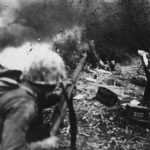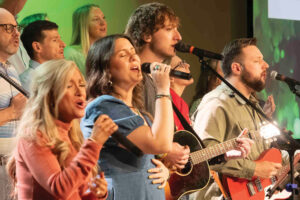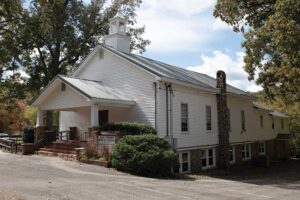

A place of memories, lore
and a storied past
Story by Joe Whitten
Photos by Wallace Bromberg Jr.
Submitted photos
Whitney Junction, lying in northwest St. Clair County at the intersection of US Highways 11 and 231, is one of the many unincorporated communities throughout the county. The original junction, however, was east of there in 1891 when the Tennessee River, Ashville and Coosa Railroad connected with the Alabama Great Southern (AGS) Railroad.
Settlers had arrived in the area long before the building of the train station in 1872, when the AGS began operation and before the US Post Office began in 1875. The station and post office were named for Charles O. Whitney, a whiskey-drinking, gambling Reconstruction Carpetbagging politician, who had been active in establishing the AGS railroad from Birmingham to Chattanooga.
Records show that James C. Ward was appointed the first postmaster on March 22, 1875. Surnames of the other postmasters ring of old St. Clair County families — Yates, Box, Beason, Early, Partlow, Sheffield and Shelton.
The First Settlers
According to Linda Moyer, a Neeley descendant, around the time that Alabama became a state in 1819, two North Carolina sisters and their husbands settled in today’s Whitney. The two couples were Elizabeth Brumfield and William McCorkle and Charity Brumfield and Thomas Neeley. Coming with the McCorkles were their daughter and her husband, Eliza Louisa and Anderson Reeves. Louisa and Anderson had 15 children.
The area grew as the Partlow, Montgomery, Sheffield, Bowlen, Allman and Harp families settled there. Children grew up, fell in love, and these families became interconnected through marriages.
Cowan Sheffield married Mary Allman, and the home they built still stands off Highway 11, just south of Reeves Grove Church. Their granddaughter, Linda Moyer, believes they built the house in the 1860s, well before the church’s organization in 1872. “The Reeves Grove Church records,” she recalled, “say that my granddaddy would start the fire every Sunday morning in the potbelly stove.”

According to Moyer, Cowan Sheffield’s uncle, Wesley Sheffield, Sr. “…rode the horse his son had brought back from the Civil War to collect money” to build the Reeves Grove Church, and that John Partlow “hewed the logs and split the shingles” for the building.
Reeves’ descendant, Joe Sweatt, recalled, “My great-great grandparents, Louisa and Anderson Reeves, donated the land to build the church on.” Sweatt told of a c1872 family letter stating that the supporting timbers of the church were cut in Etowah County, shipped down the Coosa River to Greensport, and then hauled by ox wagon to the church location.
Attendance increased in the early 2000s, and the church added a new Fellowship Hall next to the sanctuary. By 2007, having outgrown the 1872 building altogether, they constructed a larger sanctuary, connecting it to the Fellowship Hall.
Rev. Paul Alexander became pastor of the church as the new building reached completion, and he conducted the first worship service in it. A few years later, the church began Phase Two, during which they added Sunday School rooms.
Church leaders today include deacons Clarence Harris, Jerry Payne, Johnny Kuykendall and Maurice Wilkins. Jerry Payne is Sunday School director. Music director is Charles Simmons. In addition to the choir, Rev. Alexander said, “We have a group of young folks who do special singing for us.”
Three pianists serve the church: Jenny Greggs, Deb Kuykendall and Cindy Alexander. Youth Directors Zach and Stormy Davis participate in community youth services sponsored by several churches that take turns hosting services during the year.
Expressing his vision for the church, Alexander said, “Our biggest goal is to see people come to know the Lord Jesus Christ. We would love for our church to grow, but I would rather that the church grows spiritually rather than just adding numbers. We don’t focus on numbers. We focus on people getting closer to the Lord and winning folks to Christ.”
Efforts to restore the historic 1872 Reeves Grove Church are detailed in Elaine Hobson Miller’s article in the April-May 2019 Discover.
Reeves Grove School
The original deed for Reeves Grove Church stated that the Eliza Reeves hoped the building would also be a school. According to Moyer, Cowan Sheffield served as first headmaster when the school opened in the church. Later, a schoolhouse was constructed across the road to the right of where the cemetery is today.
Ashville Railroad
Montgomery’s The Weekly Advertiser reported on April 23, 1891, “The Tennessee River, Ashville and Coosa Railroad has been completed from Whitney Station on the Alabama Great Southern Railroad to Ashville, the county seat of St. Clair County. The new line is now open for traffic. The road will be extended to the Tennessee River in the north and to a point on the Southern Pacific in the south at an early date.”
Mattie Lou Teague Crow records in her History of St. Clair County that the 1890s depression forced this railroad venture into bankruptcy. She wrote, “The steel rails were ripped up for scrap iron [sic]. The old ties rotted. Today’s Whitney-Ashville highway uses most of the old right-of-way.”
The 1886 African American Church
Organized in 1886, Evergreen Baptist Church, celebrated its 133rd anniversary on Sept. 22 this year. Name are of the first members are not available, but this soon after the Civil War, they doubtless were former slaves and their children.
Rena Blunt, grandmother of current pastor Elder Paul Jones, recorded in 2007 what she remembered of the history of Evergreen Baptist. She stated that the church “was founded by the Rev. Gales and Bro. Green Neeley. The first church was a small green church facing the railroad.”
She listed the following pastors: “Rev. Woody and Rev. Shephard; Rev. Brown, 1922-1966; Rev. Bell, 1967-1968; Rev. J. C. Evans, 1968-72; Thomas Jordan, 1973; B.J. Bedford, -1990; Jerry G. Bean 1990-2016; and Elder Paul Jones, 2016-present.”
Around 1922, Mrs. Blunt recalled, the church moved to U.S. 231 where today’s BP station stands. After I-59 was created, the church moved down to its present location on Sheffield Drive.
Elder Jones, said in an interview, “The church I remember was there by the interstate where the BP Service Station is now. It was a wooden church with tarpaper siding that looked like bricks. We had boards nailed between the trees for people to sit around and eat.” The other locations he’d been told of were the one by the railroad tracks and one on Highway 11, “but its name, Evergreen Baptist, never changed.”
Elder Jones spoke of his ministry: “God called me to preach. I was teaching Sunday school in another church, and then I would come over here. For some reason, the Spirit kept leading me back here, and the next thing I knew, God had planted Rhonda and me in this church family.”
The pastor of a small congregation has more responsibilities than the pastor of a larger church. Elder Jones plays the keyboard for the singing, conducts a Thursday evening Bible study, and heads up the Sunday school, also giving a weekly review of the lesson. “My plate’s pretty full,” he observes. First Lady Rhonda adds, “We often say we both wear three or four different hats. So, whatever is going on at any time, we do what is needed.” Picking up on that theme, Elder Jones mentioned the faithfulness of Pinkie Brewster and Effie Lee Brewster. “Others may have come and gone,” he said, “but over the years, those two have been steadfast supporters of Evergreen’s ministry…When God chooses you for a task,” Elder Jones testified, “you can’t quit. The love of God will not allow you to walk away from the souls you are over.”
When asked about his vision for the church, he replied, “It’s the Word of God. I must teach with knowledge and understanding. That’s the only way — His whole Word. I wouldn’t leave anything out.” He observed that some folk skip scriptures, but Elder Jones is fervent in preaching the whole Word. “Without a vision, the people perish,” he said.
Speaking of First Lady Rhonda Mabry Jones, his wife of 42 years, he reflects that her working for the Lord alongside him was vital to his preaching effectively.
Serving Evergreen today as Deacons are Sam Blunt, Allen Looney, Henry Blunt and two Junior Deacons, Denzell Williams and Damion Jones. Elder Jones remembered two deceased deacons saying, “Deacons Robert Brewster and Earnest Brewster contributed much to God’s work here and helped make Evergreen what it is today.”
The church continues to improve the facilities as God provides. “All races are welcomed to worship together.” Elder Jones concludes, “If you’re looking for a church, come worship with us.”
Whitney, Alabama, Memories
Two articles in The St. Clair News-Aegis, Dec. 7, 1975, and July 3, 1976, record some of Nettie Lou Sheffield’s Whitney memories.
Appointed postmaster Feb. 28, 1936, Nettie Sheffield retired in 1965, and her daughter, Wanda E. Shelton, was appointed acting postmaster July 31, 1965. Official Washington, DC, records list Wanda Shelton as the last postmaster, but she was not. In 1976, Nettie Sheffield told The New-Aegis that when Wanda died soon after appointment, “The postmaster at Ashville said, ‘Take over,’ and that’s what I done. I’ve been here ever since.” Whitney Post Office was “discontinued” on March 31, 1967, and converted to a rural station of Ashville.
“There was four stores, a train depot, a honkytonk — started out as a cafe,” Nettie said in 1975. She then added a refrain probably heard since Noah had grandchildren, “but the young people hung around, and you know how they are. Well, pretty soon it was a honkytonk!” She noted that the other four stores were owned by the Montgomery, Beason, Rickles and Baggett families.
In the 1976 article, Nettie still ran the store in the building where she and her husband first opened for business in 1936. She was a month shy of 81 and still opening around 7 a.m. and closed at 4 p.m. “I figure nine hours a day is enough for anybody to work — especially if they’re as old as me,” she said.
Joe Sweatt
Having lived in Whitney all his life, Joe Sweatt has fond memories. He grew up in the family home just below where he and wife Helen live today
Asked about his memories, he said, “I guess the fondest is living close to Muckelroy Creek. Harold Whisenant and I rode our bicycles all around here back then. We took some old burlap sacks and filled ‘em up with dirt off the creek bank and dammed up the creek. My daddy built us a diving board. It was the nicest swimming hole you’ve ever seen. People from Etowah County used to come and swim there. We’d go down there in the mornings and ride on inner tubes until the sun came up and it got warm enough that we could get in that cold creek water.”
Enjoying his memories, Sweatt continued. “We always tried to save up a little money so we could go down to Hershel Montgomery’s store down at the crossroads. A Coca-Cola was a nickel and a pack of chips — corn curls — was a nickel, and he’d charge us a penny tax. He’d fuss if we didn’t have that penny for the tax.”
Prison Camp
“I remember my grandmother talking about the prison camp, Camp O, they called it, up where the nursing home is now. She used to tell me tales, about when they heard the hound dogs, they knew some prisoner had run. Even back then, they used tracking dogs.”
Wayne Ruple’s fine collection of interviews titled, Remembering Whitney, has several memories about the prison camp. O.J. Moore also remembered the bloodhounds tracking a convict, saying, “Those dogs would put him up a tree. He’d come on down and go back to camp.” Wade Partlow recalled, “The prisoners did all the local road work…They used some road machines — many pulled by horses and mules.”
Tiny McKay said, “You know Number 11 was built by convicts…. They used mules and flip scrapes…231 was built by convicts.”
The prison camp discontinued at some point, and on that property a Rhode Island couple, Pat and Carol Roberson, built the Motel Linda c1960. Jimmie Washington Keith lived in Springville and worked at the motel. She recalled that many of the I-59 workers found lodging at Motel Linda. It’s believed the business ceased operation toward the end of the 1960s.
When Motel Linda closed, Whitney Nursing Home began operation there in 1969. It had been reconstructed to meet the standards of that time. When present owner, Pam Penland, took over in 1982, it was an intermediate care facility. Today it is Health Care, Inc., and is licensed as a Medicare-Medicaid long-term nursing home. In Remembering Whitney, Wade Partlow recalled Hershel Montgomery’s store at the crossroads and that across US 231 from the store “…there was a service station…and a restaurant known as Ma Washington’s Restaurant.” In a recent interview, Mrs. Washington’s daughter, Jimmie Keith, supplied additional information. Ralph Windham owned the building where her mother, Ophelia Washington, ran the restaurant in one side, and Billy George Washington, Ophelia’s son, ran the service station in the other side. Jimmie’s nephew, Joe Cox, recalled that it was an Amoco Service Station. The service station and restaurant are gone, but on Hershel Montgomery’s corner, a store still serves Whitney Junction.
Whitney on National TV
A segment of Jack Bailey’s Queen for a Day TV show was filmed in Whitney in 1956. Mrs. Dorothy Brock, the sole provider for her family, won the title with her need to stock a small store located northeast of Reeves Grove Church near the crossroads. NBC cameramen filmed while Jack Bailey emceed and crowned Mrs. Brock as Queen.
Sen. E. L. Roberts attended and officially cut the ribbon for the grand opening of the store. The Etowah News-Journal, Sept. 13, 1956, reported that 3,000 “from many states” attended the event. Entertainment was provided as well as balloons, ice cream, soft drinks for all ages, and “500 orchids were given away to the first 500 ladies who registered.”
Viola Hyatt, Ax Murderer
Three years later, in 1959, the area again made newspaper and television headlines when Ax Murderess, Viola Hyatt, threw a torso off at a vacant house in Whitney.
Hyatt, who lived with her father in White Plains, Calhoun County, killed two of their farm workers with shotgun blasts to the face. She hacked up their bodies with an ax and scattered body parts on a road trip through Etowah and St. Clair counties.
Joe Sweatt remembered it: “We were swimming up there at the swimming hole one day, and my mother came up and said, ‘Get out; they’ve found a body up the road.’
About a quarter of a mile toward Steele from the crossroads, Viola Hyatt, the ax murderer, had dumped one of the bodies there. In those days, they didn’t secure the crime scene like they do today, and I remember we pulled off on the side of the road, and I remember looking up and seeing the body lying there.”
Fear gripped local folk and didn’t subside until Viola’s arrest. She went to trial, was convicted, and sent to prison. However, in 1970, she was granted parole. Jacksonville locals remember that she returned to the family farm and that she also ran a store in Rabbitown, and a retired Jacksonville State University professor recalled her taking classes there.
Miracle — perhaps
An article about a community should not end with a murder, so this ends with Wayne Tucker’s story of a mysteriously prevented tragedy.
“When I was a teenager,” Wayne recalled, “a Church of God minister who lived close to Whitney Junction told me and his son, my best friend, about an accident at the junction. That was a dangerous intersection before the interstate opened, as evidenced by the number of memorial crosses placed there. A bad accident happened, and several men tried to lift the car to get a man out. They couldn’t lift it. Suddenly, a big man appeared and helped lift up the car. By the time the rescuers attended to the crash victim, the big man was nowhere in sight — and nobody saw him leave.”
Just the extra man needed to lift the car or a miracle? Who can say? However, Tucker remembers the minister as a godly man who gave God the credit for the man’s rescue. A miracle is much better than a murder. Somebody say, “Amen!”















